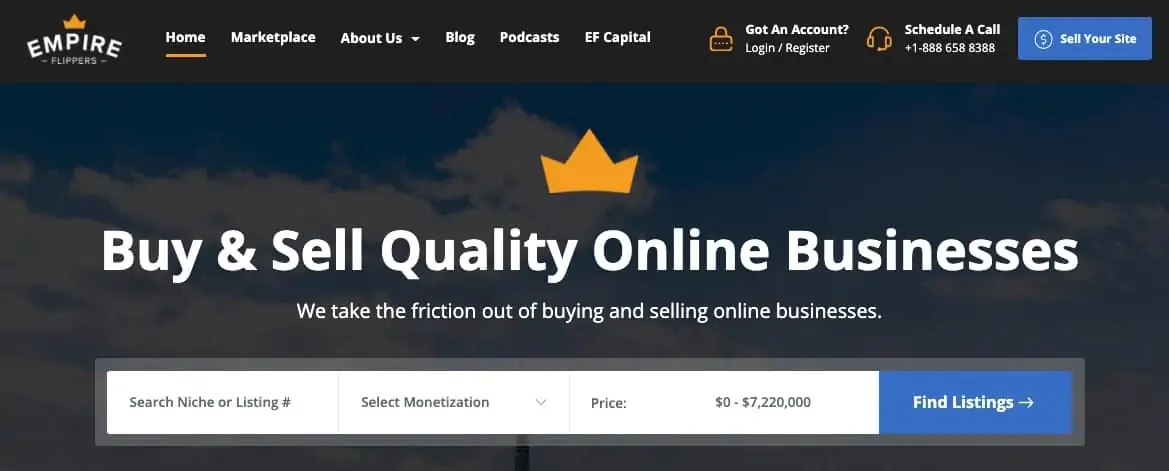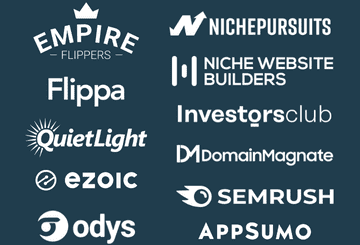Blogs aren’t just a great source of potential passive income, but they can result in large one-time payments from a sale. Whether or not your blog is worth selling is going to depend on its worth and if that number is high enough to make you willing to sell.
Determining the exact valuation relies on some common formulas as well as some other mitigating factors that can affect how much investors are willing to pay.
So how do you know how much your blog is worth?
We’ll jump in on the conventional valuation formula, additional factors, positioning for sale, knowing when to sell your blog, or how to know if you even should!
Try The Blog Worth Calculator
Below you will find a valuation calculator where you can enter basic data about your site and get an estimated valuation.
Why Sell a Blog?
Selling a profitable blog can be a tough decision but there are many scenarios where it makes a lot of sense.
Just some of the good reasons for selling a profitable blog could include:
- You could use the money from the sale for a new or more profitable business
- You’ve become bored or disinterested in the current blog topic
- The large one-time payment from a sale is worth more to you than the monthly cash flow
- You see more opportunities/less competition in other niches
Any of these make a good reason for selling a profitable blog. For someone who wants to understand the full process of making money online with websites, selling an initial blog can be a very important part of that process.
When To Sell Your Blog?
Timing matters. Too many blog owners see one or two good months and then decide to put the site up for sale. This is a bad move for multiple reasons.
1. Know the Sales Valuation Formula
One is the formula itself. Since the numbers requested will be the last six months of income, and possibly the last 12 months, you don’t want to sell a site before seeing the full benefit of those high revenue months.
Holding onto the site for 6-12 more months means those terrible $20 revenue months from the beginning get cut, replaced in the average by the newer high revenue months. This has a drastic effect on the overall price for a niche blog.
2. You Know You’re Done with It
Building a blog takes a lot of work. Even if the topic was exciting or interesting in the beginning, chances are there’s a time when the interest wanes. If the excitement is gone, if you’re not imagining new goals, if working on the site is much more of a stressful chore than another task, then it’s a good sign maybe it’s time to sell.
If the site has hit a plateau in its earnings over a long period of time and you’re more interested in growth than steady passive income, then that’s another strong sign that it’s a good time to sell.
A blog that is left alone is more likely to decline over a long timeline rather than grow or maintain because of new competition, Google looking for new content, and other relevant factors.
3. Is There a Seasonal Effect?
A seasonal topic blog can create more excitement before that season than after. For example, someone looking to invest in a site will likely be more excited about a skiing site in early autumn as opposed to early spring.
If it’s clear that the next big seasonal bump for the site hasn’t happened yet, that excitement can lead to a bigger selling price, especially in the form of investors willing to pay a larger multiple.
How To Determine My Blog’s Worth
Determining the overall worth of a blog is more about finding a range as opposed to an exact dollar amount. Understanding valuation isn’t the full story, but it’s a crucial step in accurately estimating your blog’s value.
Valuation Methods
Let’s start with the standard valuation method. Some form of this is likely to be used by every seller, and it’s the fallback even for brokers, marketplaces, and potential buyers willing to consider other details.
The standards valuation method for a content website is as follows:
The average monthly income is generally based on the last 6 months of income added together and divided by six. Some sellers prefer to use 12, which is also fairly common for seasonal blogs.
MM stands for monthly multiplier and will always be a range based on whatever the market is paying for content sites at the moment. So the multiplier could be between 30 to 40. This number changes as demand in the market changes.
How to Calculate Blog’s Profit and Loss
Calculating a blog’s profit and loss is an important part of getting the most out of any sale.
Here is an example spreadsheet you can utilize:
Get Your Revenue Numbers
The total revenue numbers are part of the equation. This is total revenue. Display ads, Amazon sales, other affiliate sales, leads, sponsorships, whatever the income source it needs to be pulled together.
Keep in mind that revenue that requires active work versus passive (like negotiating sponsored posts or sponsored links) should be only counted at the discounted number (typically 50% of earnings). There are various reasons for this, but this is a more accurate reflection on a P&L statement.
A good spreadsheet allows you to see every income source individually while also tallying up the total revenue number you’ll need.
Get Your Operational Costs
Operational costs include hosting, email, paid plugins, domain renewal fees, yearly fees amortized out to monthly averages, and content that is for maintenance. Content bought to ramp up the site does not count as operational costs.
Here is a full list of operational costs:
- Domain renewal fees amortized
- Monthly hosting fees
- Email service provider subscription fees
- Social media tool fees
- Content needed for maintenance
Determine Profit
Revenue minus operating costs equals the profit for each month. This should be done every month on the P&L statement, but growth costs should never be added in. Only the maintenance/operational costs.
4 Factors That Influence The Price of a Blog
While revenue and profit is the major factor that determines the valuation, some other factors make a difference.
These are often factors that determine whether you will be getting a multiple on the low side of the common range or the high side.
1. Diversified Income Sources
Is your blog one that has four or five different income streams or does it rely solely on one source for 100% of its revenue?
Having multiple sources of income makes a site much more attractive to investors. That way if Amazon cuts their affiliate rates again, a different affiliate program shuts down, or display advertising weakens, the site is still profitable. It still has multiple other income streams making up for anything lost.
2. Domain Name Value
A domain name that has a long history, strong marketability, or excellent branding can make the site more valuable. Best X .Com or X Reviews .Com domain names are a dime a dozen. So are 2-5 year old domains.
If a domain comes along that has a 12-year history and is Good X .Com or even just X .Com that is a domain name that stocks out, may even have direct traffic, and is more valuable.
3. Traffic Numbers & Sources
High traffic numbers will get attention, especially if:
- Most traffic comes from organic search
- There are multiple sources of traffic
Generally, organic search traffic is considered the best source of traffic. However, seeing direct traffic, searches for the brand/domain, and social media traffic are all positive signs. These are fortifications against changes in search engine algorithms that can cause massive traffic swings.
4. SEO Factors
SEO factors play a major part in how potential buyers view a blog for sale. Here are the major factors to consider:
Rankings
How many high demand or buyer intent keywords does the blog rank for? How high on page one of the search engines are the articles on this blog?
Looking at the number of rankings, number of keywords that drive traffic, and the room for growth or security of those ratings all plays into what makes a blog potentially more valuable in the eyes of investors.
Quality of Backlinks
The number of backlinks aren’t the only thing that matters, but rare high-quality backlinks can be a major boost to a blog’s value.
Think of links from huge authority sites like The New York Times, The Chicago Tribune, Microsoft, or other truly authoritative websites. These are hard to get and make a domain name very strong for SEO purposes.
If your site collected many of these, that can often radically increase the value of what buyers are willing to pay for a blog.
Manual Penalties
A history of manual penalties is going to be a serious problem. This will take down the value of a site, while a long history with no manual penalties, or maybe a single one from many years ago that was corrected, will be a positive sign for a blog’s value.
Getting a Third Party Blog Valuation
Third party blog valuations can vary quite a bit, although most use the same basic formula, at least when it comes to content sites or blogs.
Getting feedback from a third party can help to pin down a more exact potential sales value for your blog.
Private Brokers
Private brokers will have their own review system for looking at all aspects of a site, how it compares to what any existing pool of buyers they would like to see, and come back with an offer or range.
Many offer an initial estimate before you need to sign anything binding, so seeing what a few reliable and trusted private brokers come back with is a good strategy. Especially if they include a pros/cons analysis of why they came up with the monetary value they quoted.
Empire Flippers

Empire Flippers is one of the largest and most trusted curated marketplace for buying and selling websites in the world. Getting a quote from a site that buys/sells thousands of properties a year is a very smart way of getting a realistic idea of what the current markets are valuing blogs like yours at.
Flippa

Flippa is an open marketplace, but it’s another spot where you can get a valuation on a blog.
Flippa uses an intelligent valuation engine to determine what they see a blog as being worth. It’s another way to get a more accurate asset valuation from an experienced source.
How to Increase the Value of My Blog: 3 Tips
Site owners can take several actions to improve the value of their blog, especially on a 6-12 month timeline.
1. Publish New Content Around Low Competition Keywords
Every niche has low competition keywords that get at least some traffic. Outsourcing to push out 100 articles around low competition keywords a site can rank for fast and easily leads to big surges in traffic, which means more revenue.
Both numbers are important for increasing the value of a blog. The sheer mass of extra content can make a site carry a bit more authority SEO-wise, and more content that ranks means more natural backlinks will trickle in.
Massive publishing of new content targeting low competition keywords is one of the best ways to quickly increase the value of an established blog.
2. Diversify Traffic Sources
Look at other traffic sources. Is there a search engine that your site isn’t getting the attention of? How much traffic is coming from Twitter, Facebook groups, Quora, or Pinterest? Do you have a YouTube or TikTok channel?
There are many different ways to create new traffic sources. This not only leads to more traffic, but that diversification is something buyers love to see.
3. Increase Size & Conversion of an Email List
An email list can be a powerful tool, especially in increasing the value of a site. The size of the email list matters, but so does the conversion rate. A large email list is great, but if the interaction is trash, then it’s not nearly as good.
Working to not only increase the size of an email list but the interaction/conversion rate will give a huge boost to the potential sales value of a sale.
Takeaways
Determining how much your blog is worth takes some work, but it is possible to have a good idea of the price range you could be looking at with a sale. By running the numbers, researching the numbers on your own site, and pulling together the reports, you can fairly accurately predict the potential value of your blog.
Getting a public or private broker to create an estimate can help to confirm that estimate, or show you where your own estimates went astray.
Following the advice in this article gives you all the tools you need to get multiple good estimates on the value of your blog as a sellable asset.



